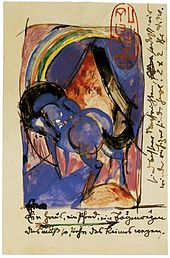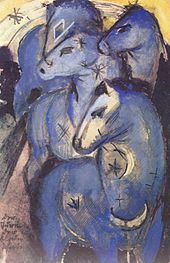Artist postcard
An artist postcard is an artistic postcard designed by the artist himself , the design of which is originally intended for use on a postcard . It is either sent by post by an artist to relatives, artists or museums or remains unsent as an object. Some of them are unique and addressed to a single addressee.
definition
In addition to cards printed in larger editions, there are also individually painted unique pieces . There are also subsequent reproductions of existing works of art, which z. B. were previously designed as paintings , but are more likely to be described as art postcards. The picture cards specially designed by artists that are intended for series production, such as those used for B. were manufactured by the Wiener Werkstätte . The artist postcard is to be distinguished from the works conceptually understood in Mail Art as part of an ongoing network.
In the English-speaking world, there is the term artist signed postcards for this, according to the designation, these are postcards that are marked with the name of the artist. However, there are some artist cards that are published anonymously or under a pseudonym that hardly achieve the high prices of the famous names.
history

The postcard was introduced in Germany in 1870, and in Austria as a correspondence card as early as 1869. The painter Philipp Franck , landscape and genre painter, sent on Friday, 11 June 1880 from Kronberg im Taunus , a postcard of the German postal to his sister Lilly Franck to Frankfurt . In the second sentence, the card provides a caption for a pen drawing with watercolors and raised white on the reverse, which was transformed into an artist's postcard by stamping the Reichspost. Today it is considered the first of its kind and has the rank of an incunable .
At the beginning of the 20th century, the artists of the expressionist artist group Brücke, such as Ernst Ludwig Kirchner , often sent postcards as greetings to their friends or sponsors, such as Rosa Schapire . The printed, drawn or water-colored postcards are works of art in miniature format that were shown in an exhibition at the Brücke Museum in Berlin in 2012 under the title Beste Gruß. Artist postcards of the "bridge" were shown. They bear witness to the life and work of the artists and served as source material for research. The postmark helped clear up dating issues. Some motifs gave an idea of works that no longer exist today or served as an idea for implementation in a painting or printmaking.
From 1912 onwards, the co-founder of the Der Blaue Reiter editorial group , Franz Marc , sent the poet Else Lasker-Schüler a total of 28 hand-painted greetings. The watercolor The Tower of the Blue Horses was a New Year's greeting for 1913 and is the only surviving colored design for the oil painting of the same name, which has been lost since 1945 .
In addition to Franz Marc, it was Paul Klee , Heinrich Campendonk , Lyonel Feininger and Robert Delaunay from the area around the Blauer Reiter who sent out numerous elaborately designed postcards in 1913/14. The cards are no longer sketchy, but detailed images, some decorated with silver and gold leaf. This phase of artist postcards ended with the outbreak of the First World War . After the war it was only a few artists who continued the ideas of the Brücke and the Blauer Reiter. The Dadaists followed with ironic, provocative works as "anti-art". The collage is the element of Dadaist postcard art. Later, for example, in the 1960s they were represented in the art movements Fluxus and Conceptual Art ; traditional and avant-garde techniques are currently being executed side by side.
Examples of cards

Artist postcard number 542 of the Wiener Werkstätte , anonymous artist, around 1911
Typical genres and example artists are:
- Beautiful women ( Raphael Kirchner ), Art Nouveau artist
- Fashion ( Mela Köhler ),
- Children ( Frances Brundage ) or
- Congratulations ( Samuel L. Schmucker ).
There are also advertising postcards designed by well-known artists, a well-known series is the Collection des cent . In general, these cards do not come from series. There were a particularly large number of Art Nouveau copies when the popularity of postcards reached its peak. Contemporary cards are now available, for example, as free postcards . Bauhaus cards and cards from the Wiener Werkstätte are among the most expensive postcards and sometimes reach prices of over 10,000 euros at auctions.
Exhibitions
- Painted postcards and letters by German artists in the Altona Museum , Hamburg, 1962
- “The artist postcard - from the beginnings to the present” in the Altonaer Museum, Hamburg, North German State Museum, March 4 to June 8, 1992 and the Deutsche Postmuseum , Frankfurt, June 30 to September 13, 1992
- Best regards. Artist postcards from the "Brücke" , Brücke-Museum Berlin , 25 May to 23 September 2012
- Picture letters, artist postcards, Mail Art , Akademie der Künste , Berlin, August 30th to December 8th, 2013
- Kirchner, Schmidt-Rottluff, Heckel and Pechstein send their regards. Expressionist artist postcards , Osthaus Museum , Hagen, August 24 to November 2, 2014
- Exhibition in the E. Scharff Museum in Neu-Ulm from January 31 to May 3, 2015
literature
- Le avanguardie artistiche e la cartolina postale. Cantini, Firenze 1989, ISBN 88-7737-076-9 .
- Postcards & artist cards. A cultural-historical documentation. Exhibition catalog. Galerie Arkade, state art trade of the GDR. VEB Fachbuchdruck, Naumburg 1979.
- Signed Artist's Cards. In: Marian Klamkin: Picture Postcards. Dodd, Mead & Company, New York 1974, ISBN 0-396-06889-8 , pp. 45 ff.
- G. Fanelli, E. Godoli: Art Nouveau Postcards. Rizzoli, New York 1987, ISBN 0-8478-0832-7 .
- Bärbel Hedinger (Ed.): The artist postcard. From the beginning to the present . Prestel Verlag, Munich, and Altonaer Museum in Hamburg 1992, ISBN 3-7913-1197-2 .
- G. Kaufmann, M. Meinz: Art and Postcard. In: Archive for German Postal History , Issue No. 1/1970.
- Gerhard Wietek : Painted artist mail. Cards and letters by German artists from the 20th century. Verlag Karl Thiemig, Munich 1977, ISBN 3-521-04073-9 .
- Jörg Deuter: Gerhard Wietek. Drawings on postcards. In: Journal für Kunstgeschichte , 14, 2010, pp. 50–56.
- D. Thura: Repertoire des cartes postales dessinées , Sedli, Hounoux 1984
Web links
- Postcards Lexicon: Artist cards
- collectorsweekly.com: artist-signed postcards (English)
- metropostcard.com: artist signed postcards (english)
- Postcards to Rosa Schapire in art-magazin 08/2009
Individual evidence
- ↑ Thomas Fürst, Günter Formery: The world of collecting postcards. Publisher: Phil Creativ, Schwalmtal 2011, ISBN 978-3-932198-91-5 , p. 116 f.
- ↑ Traude Hansen (ed.): The postcards of the Wiener Werkstätte. Directory of artists and catalog of their work. Inventory catalog on the occasion of the exhibition “Die Künstlerpostkarten der Wiener Werkstätte” in the Austrian Museum of Applied Arts, Vienna (from May 19, 1982). Schneider-Henn, Munich / Paris 1982, ISBN 3-923239-01-7 .
- ^ Bärbel Hedinger : Artist, Post, Card - an introduction . In: Bärbel Hedinger (Ed.): The artist postcard. From the beginning to the present . Prestel Verlag, Munich 1992, p. 11
- ↑ Quoted from the Brücke Museum's web link
- ^ Susanna Partsch : Marc . 9th edition, Taschen Verlag, Cologne 2009, ISBN 3-8228-5585-5 , p. 67
- ↑ Compare the corresponding illustrations and comments in: Franz Marc - Else Lasker-Schüler, The blue rider presents your highness his blue horse, cards and letters . Edited and commented by Peter-Klaus Schuster. Prestel, Munich 1987, ISBN 3-7913-0825-4 .
- ↑ The history of postcard art ( Memento of July 22, 2014 in the Internet Archive ), deutschepost.de, pp. 6, 7, quoted from Bärbel Hedinger: Die Künstlerpostkarte



